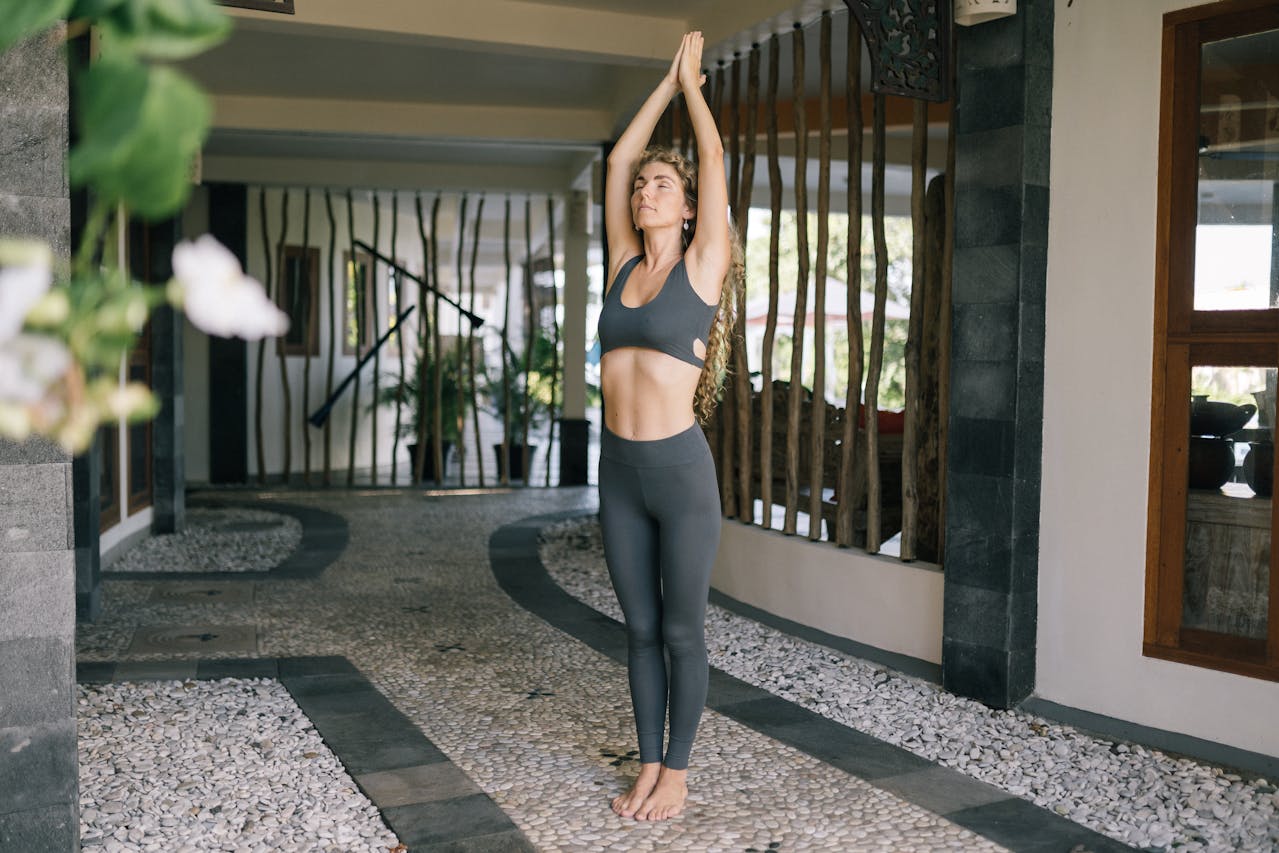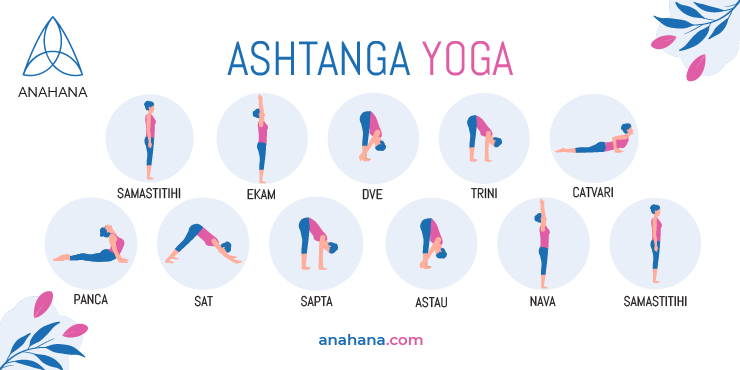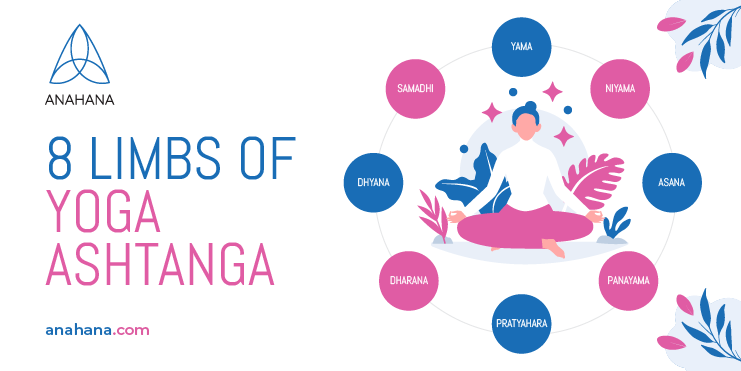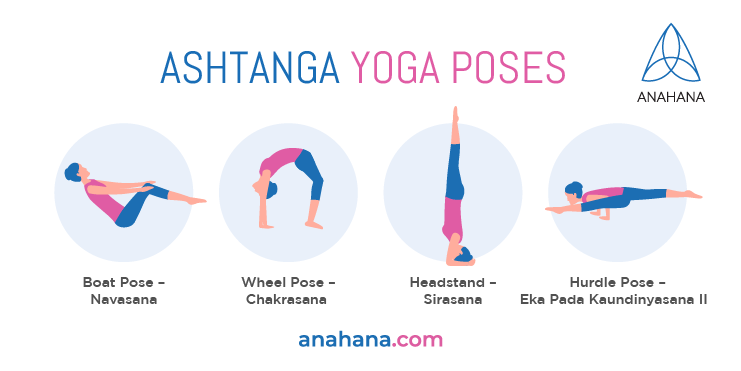
Table of Contents
Ashtanga yoga means eight-limbed yoga and is a structured vinyasa-style type of yoga. The style is physically demanding, focusing on asanas and breathing.
The history of Ashtanga yoga
 Ashtanga yoga, also known as Ashtanga Vinyasa yoga, Military yoga, or the original power yoga, is a traditional practice with roots in India. Its' origins derive from the 5000-year-old yogic text Yoga Korunta, written by Vamana Rishi. Patanjali compiled this ancient writing between 200 and 400 C.E. and created the Yoga Sutras.
Ashtanga yoga, also known as Ashtanga Vinyasa yoga, Military yoga, or the original power yoga, is a traditional practice with roots in India. Its' origins derive from the 5000-year-old yogic text Yoga Korunta, written by Vamana Rishi. Patanjali compiled this ancient writing between 200 and 400 C.E. and created the Yoga Sutras.
Tirumalai Krishnamacharya studied these Sanskrit texts with guru Ramamohana Brahmacharya while living in a cave in the early 1900s. In 1931, Krishnamacharya began teaching at the Sanskrit College in Mysore, India. It was here that he eventually taught Sri K Pattabhi Jois. During this time, the Ashtanga yoga style that we are familiar with today was established.
Pattabhi Jois developed and popularized Ashtanga yoga, opening up the Ashtanga Yoga Research Institute in Mysore in 1948. He created the Yoga Mala, which outlines the Ashtanga yoga method. He brought the practice out West when he taught his first workshop in California in 1975.
Since then, it continues to be taught and practiced throughout western societies.
What is Ashtanga Yoga?
Ashtanga yoga was the first form of Vinyasa yoga. The word “vinyasa” refers to techniques that link breath to movement, creating a swift-flowing sequence of asanas. The difference is, in Ashtanga yoga practice, the series of postures remains the same each time.
However, there are six sequences that you can advance to. Once you master the first level, your instructor will move you up. Each ashtanga series will include a variety of seated poses, standing poses, and some pranayama.
The six series of Ashtanga yoga
There are six series of Ashtanga yoga:
The first series is called the primary series or yoga chikitsa, and the second series is called the intermediate series. Following these are four advanced series. Each of these sequences has a set of ordered postures performed the same every time. They will begin with a series of poses called Sun Salutations, also known as Surya Namaskar. This variation will repeat five times, and the Sun Salutations B variation will repeat three to five times.
A standing sequence will follow this. This pattern will remain the same in all six series, and only the middle section of asanas will differ. All poses will be practiced in a Mysore style, which means that the teacher will provide the students with new, more advanced poses once they appear ready.
The eight limbs of yoga
 Ashtanga yoga follows a specific philosophy and wisdom of teachings. The literal translation of ashtanga is eight limbs. These are practices that guide how to make your life meaningful through moral and ethical lessons on the self. The sequence goes from the outer to the inner.
Ashtanga yoga follows a specific philosophy and wisdom of teachings. The literal translation of ashtanga is eight limbs. These are practices that guide how to make your life meaningful through moral and ethical lessons on the self. The sequence goes from the outer to the inner.
The eight limbs consist of the following steps:
Yama: This focuses on ethical standards and integrity, teaching best practices for behavior and how we present ourselves. The five Yamas are Ahimsa (nonviolence), Satya (truthfulness), Ateya (non-stealing), Brahmacharya (continence), and Aparigraha (non-covetousness).
Niyama: The second limb has to do with spiritual observance and self-discipline. Examples of Niyama are saying grace before a meal or taking nature walks alone.
The five Niyamas are Saucha (cleanliness), Samosa (contentment), Tapas (heat; spiritual austerities), Svadhyaya (study of the sacred scriptures and one's self), and Isvara Pranidhana (surrender to god).
Asana: Asanas are the postures that are practiced in yoga. We develop a deeper concentration and discipline by practicing asana, preparing us for the following limbs.
Pranayama: Pranayama generally translates to breath control. It is designed to recognize the connection between breath, the mind, and emotion, to gain control over the respiratory system.
The exact translation of pranayama is "life force extension." This is because yogis believe it can extend one's life.
Pratyahara: The fifth limb is to withdraw from external distractions and bring your attention within. By detaching from the senses, you can observe your internal thoughts and begin to view them in a new light.
Dharana: At this point, you will be relieved of outside distractions and focus on concentration. Here, you will learn to slow down your thinking process by drawing your attention to only a single object.
Learning to focus on a single point for extended periods will naturally lead to meditation.
Dhyana: This is the uninterrupted flow of concentration (Dharana) - also known as meditation. In this state, you will be fully aware and awake without focus. Reaching this state of stillness will take strength and stamina.
However, it is part of the process, and you will benefit from the practice as you work toward your goal.
Samadhi: This is the eighth limb and the final stage of ashtanga. Patanjali describes this as a state of bliss or ecstasy. During Samadhi, the person meditating will emerge with their focus and transcend the self altogether.
They will reach an interconnectedness with all living things and experience the overwhelming euphoria of being at one with the universe.
The benefits of Ashtanga yoga
Ashtanga vinyasa yoga has extensive benefits for the mind, body, and soul. Here are four of the many health improvements you may reap from regular practice:
Increases psychological well-being: Ashtanga yoga reduces stress and anxiety by calming the nervous system.
One peer-reviewed study enrolled twenty children who experienced anxiety and depression in a 12-week Ashtanga Vinyasa yoga program. When the program was complete, four in five of the children had improved self-esteem and reduced symptoms of anxiety and depression. The practice promotes inner peace, mindfulness, and awareness, improving overall psychological well-being.
Improves flexibility and strength: Many of the postures in ashtanga have you hold your body weight on your hands or balance on one leg. This builds strength in your core and increases your general body strength. In addition, it helps tone muscles and improves flexibility over time.
Weight loss: Ashtanga yoga aids in weight loss. It is an intense cardiovascular workout that effectively burns calories through strength training and muscle-building postures.
Moreover, relieving stress through asanas can help you lose weight. Frequent or daily practice will be most effective in helping you reach your weight loss goals.
Lowers blood pressure: Several studies indicate that regular practice lowers blood pressure. It does this through the breathing technique known as Ujjayi pranayama, which is practiced during ashtanga. This has you contract your throat and make a whispering sound as you breathe through your nose.
Many peer-reviewed studies suggest that this breathing technique lowers blood pressure. In addition, Ashtanga yoga is an excellent cardiovascular workout helping to stabilize blood pressure.
Ashtanga yoga poses
 Here are some of the more advanced yoga poses that are included in some Ashtanga yoga classes:
Here are some of the more advanced yoga poses that are included in some Ashtanga yoga classes:
Boat pose (Navasana): Begin sitting with your knees bent and feet flat on the floor. Engage your inner thighs and core, tip your weight back on your sit bones, and lift your feet to knee height. Bring your arms parallel to the floor. If you feel comfortable and well-balanced, straighten your legs. Hold for several breaths. Bring your feet down to the ground as you exhale and return to a seated position to exit the posture.
-
Benefits: This posture strengthens the abdominal muscles, hip flexors, and spine. In addition, it can improve digestion.
-
Risks and contraindications: Although generally safe, you should not practice boat pose if you are experiencing a headache, low blood pressure, or diarrhea. Moreover, people with asthma or heart problems should softly practice the Half Boat pose rather than the full variation.
Wheel pose or upward bow pose (Chakrasana): This challenging posture requires a certain level of flexibility and strength. Begin by lying on your back with your feet flat on the floor and your heels as close to your sit bones. Bend your elbows and place your palms on the floor beside your head. Point your fingers toward your shoulders. Actively pressing the feet and palms into the ground, exhale and push your pelvis toward the sky, firming and lifting the buttocks off the floor. Keep your feet, knees, and arms parallel. Stay in this pose for up to ten seconds. Repeat anywhere from three to ten times.
-
Benefits: This posture has extensive benefits, including stretching the chest and lungs and strengthening the arms, wrists, legs, buttocks, abdominals, and spine. In addition, it stimulates the thyroid and pituitary glands, increases energy, and counteracts depression. Lastly, this posture is therapeutic for asthma, back pain, infertility, and osteoporosis.
-
Risks and contraindications: Avoid this posture if you are experiencing a back injury, headache, heart problems, carpal tunnel syndrome, diarrhea, shoulder problems, or high or low blood pressure.
Headstand (Sirsasana): Beginners should start with a modified version of the headstand by trying the posture against a wall and on a mat. Begin in a thunderbolt pose, and measure out the appropriate elbow width by placing your hands at the base of your upper arms. Maintain this position and place your elbows down. Bring your hands together, interlace your fingers and place the tips of your pinky fingers together, opening your palms and thumbs. Put the top of your head on the mat, lift your hips, and straighten your legs. Walk your feet toward your body and lift your hips above your shoulders. Slowly, bring your knees in toward your chest. Hold this position for several seconds as you find your balance, and extend your legs into a full headstand when comfortable.
-
Benefits: Headstand calms the mind to alleviate stress, anxiety, and depression. In addition, it activates the pituitary and pineal glands and stimulates the lymphatic system. It may prevent headaches, boost digestion, and alleviate symptoms of menopause. If practiced regularly, it can strengthen the upper body and enhance lung capacity.
-
Risks and contraindications: There are risks of injuring the neck, shoulder, and back in this pose. Moreover, inversion therapy is not safe for everyone. We recommend you speak with your doctor first if you are unsure that this posture is for you. While you are in the pose, your blood pressure will increase, and your heart rate will slow.
Avoid performing headstands or other inversion positions if you have a heart condition, high blood pressure, glaucoma, osteoporosis, a fractured back or leg, or a hernia.
Hurdle pose (Eka Pada Kaundinyasana II): Begin in a lunge with your right foot forward and your hands in front of your foot. Raise your front heel off the floor and work your right shoulder under your leg, then lower your heel and plant your hands on the floor on either side of your front leg. Lift your shoulders away from the floor and raise your front leg off the floor. With your right leg extended in front of you, use your toes as a lever, shift your weight forward, and see if you can lift your back foot off the ground. You will have to search for the sweet spot that allows both feet to hover off the floor. Put your back foot on the ground and take your front foot back to downward facing dog to exit the posture.
-
Benefits: This posture builds muscles in the shoulders, chest, arms, abdomen, spine, hips, hamstrings, and core. It activates the internal organs and strengthens the abdominal muscles.
-
Risks and contraindications: Make sure you stretch before performing hurdle pose to avoid straining any muscles. Avoid the pose if you have a wrist, shoulder, lower back, or elbow injury. In addition, those who are pregnant or menstruating should not practice it. If you have high blood pressure or a hernia, do not practice this posture.
Keep in mind that these yoga poses are for experienced practitioners.
If you are a new student, you should not perform anything uncomfortable, even if it is incorporated into the sequence. If you are a beginner yogi, speak with your teacher regarding your comfort level and experience before registering for a course.
Remember, your instructor will not ask you to perform these postures until they believe you are ready.
Frequently asked questions
What is the difference between Vinyasa and Ashtanga yoga?
The most significant difference between Vinyasa and Ashtanga yoga is sequencing; however, they are still very similar. Vinyasa class sequences vary and can be completely different each time. In contrast, Ashtanga yoga has six distinct variations performed the same way each time.
When to practice Ashtanga yoga?
Although you can practice Ashtanga yoga at any time, some yoga traditions advocate for asanas early in the morning before the sun rises. Many ashtanga practitioners who practice yoga in their homes stick to this routine.
In addition, most Mysore classes are offered at this time.
Is Ashtanga yoga hard?
Yes, ashtanga is a more physically demanding style of yoga. An entire primary series takes at least 90-minutes to complete - longer than most yoga classes.
However, if you have experience in vinyasa yoga and feel prepared to advance your skills through ashtanga, it is worth it. Columbia University researchers reported that their 2007 study found one hour of beginning Ashtanga yoga is similar to 20-minutes walking on a treadmill. First at a slow pace and continually more briskly. It will be a challenge at first, but it will become easier over time.
Is Ashtanga yoga good for weight loss?
Ashtanga yoga offers a vigorous cardio workout. It can help you lose weight by building strength, burning calories, staying fit, and raising your heart rate. Ashtanga yoga is a category of vinyasa yoga, which is the most effective style of yoga for weight loss.
Is Ashtanga yoga dangerous?
There is a chance of injury during Ashtanga yoga if not practiced with care and caution. Many people become obsessed with advancement in Ashtanga yoga, causing them to perform postures they are not prepared for. You may still practice ashtanga beginning with the primary series and move up as your skills progress.
Make sure you master the first series before moving on to the next. And keep in mind, this can take years. In addition, as you are practicing in large groups, teachers often do not teach modifications unless requested, making the risk for injury higher.
How does Ashtanga yoga change your body?
Regular Ashtanga yoga can rejuvenate the body. It increases strength, tones muscles, enhances flexibility, and teaches control. The opening series in an ashtanga class, which remains the same at all levels, includes contortion-esque poses requiring adequate core and arm strength.
In addition, your stamina and endurance will improve gradually, and your core muscles will get stronger.
How to start Ashtanga yoga?
To begin practicing Ashtanga yoga, find a local studio that offers these classes. It is unlikely that you will discover ashtanga classes at a recreational center or gym. Therefore, you will have to research yoga studios in your neighborhood to find these classes.
In a traditional Ashtanga yoga shala, the “Mysore'' style of practice is where students go through the routine series on their own and at their own pace, with hands-on assistance from an instructor as necessary. It is usually practiced between 6:00 AM to 8:00 AM. And the “lead” class style, where an instructor verbally guides the practice and all students practice in unison, is offered on Saturdays. Sundays are considered a rest day.
Another tradition is to practice following the moon’s cycle so that there will be no classes offered on full moons and new moons. Observing moon days is one way to respect and follow the rhythms of nature so we can live in greater harmony with them.
When you find a studio, it is best to begin by registering for an Ashtanga yoga primary series course. This is the first and most basic level. Starting from the beginning will give you room to progress as you advance your skills safely. From here, there are five more series you can move up to, although it is relatively rare and unnecessary for most people to get there.
Is Ashtanga the most challenging yoga?
Although it is unique to each person’s skill set, many people consider ashtanga the most challenging style of yoga practice. Even the primary series, the most basic series, can take up to two hours to complete. This makes it quite physically demanding. In addition, even the most basic series requires you to perform advanced postures, including boat pose, headstand, and wheel pose, as previously outlined.
References
Ashtanga Yoga The Primary and Intermediate Series.
Ashtanga Yoga IS Hard—A Beginner's Guide to How to Practice – OmStars.
How to do Boat Pose or Navasana - Ekhart Yoga.
Good for the mind, but how about the body? - Harvard Health.
The Ancient Origins of Ashtanga Yoga and Why It's Still Popular Today.
Surprising Benefits of Ashtanga Yoga.
Wheel Pose: How to Practice Urdhva Dhanurasana or Upward-Facing Bow Pose
Disclaimer
The contents of this article are provided for informational purposes only and are not intended to substitute for professional medical advice, diagnosis, or treatment. It is always recommended to consult with a qualified healthcare provider before making any health-related changes or if you have any questions or concerns about your health. Anahana is not liable for any errors, omissions, or consequences that may occur from using the information provided.

By: Clint Johnson
Clint is the driving force and founder of Anahana. Clint teaches Yoga, Pilates, mindful breathing, and meditation, catering to a global community of students and teachers.
